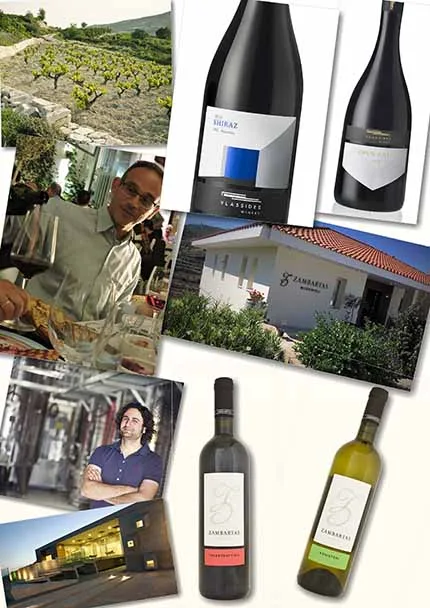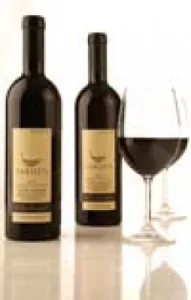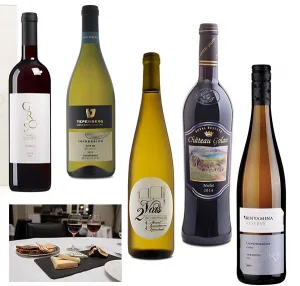My personal infatuation has always been with the wines of the Eastern Mediterranean. I believe the Eastern Mediterranean is one of the most interesting and fast developing wine regions. The wines of Lebanon and Israel are so different, yet complimentary. The wines of Cyprus, Greece & Turkey are more exotic because of the prevalence of all their indigenous varieties. There is something intoxicating about the high-altitude vineyards, poor stony soils and Mediterranean climate that make this region a wine haven. Certainly, it is a winemaking paradise and the wines have improved no end.
In ancient times this region was the France & Italy in terms of wine production, indeed this is the region that gave wine culture to the world. The importance of wine in western Judeo-Christian culture today, is because of its importance then, in this same place. The current renaissance of the Eastern Mediterranean is exciting and it has become a dynamic region, which combines modern technology, a perfect terroir against a backdrop of traditions from the ancient wine world.
As for me I came to the idea of thinking regionally gradually. I learnt thirty-five years ago that making an Eastern Mediterranean section of a wine list was more interesting to the wine consumer that choosing one country only to represent the wine region. I remember putting Chateau Musar from Lebanon and Yarden Sauvignon Blanc on the wine lists of the Crest Hotels International Group in the late 1980’s and heading it the ‘Eastern Mediterranean’. It somehow made the inclusion of the wines more exotic and attractive, than if they had been listed on their own. From this I learnt of the potential of marketing different small countries from a similar region together.
I discovered that what is true from a marketing and retail point of view, is also true of the media. When I came to Israel, by now working for the Golan Heights Winery, I tried to attract a famous wine journalist to commit to coming here in the early 1990’s. Budgets were arranged, but to my dismay, a visit to Israel alone was not enough to justify the effort as far as he was concerned. A visit to most wine regions of the world can prompt many ideas and reasons for coming. Winery & vineyards abound and are reasonably close to one another. It is possible to hop from region to region quite easily in Europe.
In this instance, I realized the writer needed more to put Israel in context. So a combined visit to Lebanon and Israel was then arranged (travelling via Cyprus). This gave the writer more material and a broader subject. He came here and went to our neighbors. As a result he wrote many articles from different angles from what he saw, heard and tasted. I repeated the Israel – Lebanon recipe with others. I realized that Israel, Lebanon and Cyprus considered as a region would fit comfortably into California, for instance and from a media point of view, there was more interest in the region, than in the individual countries alone.
In the early 2000’s, by now working for Carmel Winery, I arranged sponsorship at the IWSC in London for the ‘Trophy for the Best Producer in the Eastern Mediterranean.’ I wanted to promote recognition of the region, encourage improvement in quality and highlight the successes. I digress, but imagine my pleasure on an unsolicited visit to the Gerovassiliou Winery in Greece a few months ago, and seeing the winning certificate for this trophy hanging up in his cellar.
My unfulfilled dream at this time was to create a wine marketing consortium called ‘Wines Without Borders’, which would feature wineries from Cyprus, Greece, Israel, Lebanon and Turkey. Israel & Lebanon are technically at war, Greece and Turkey are at each other’s throats and Cyprus is a country divided between Turkish Cypriots & Greek Cypriots. It is a region divided by borders of war and religion, but there are similarities, like the coffee,mezze and terroir. I even went to the extent of contacting possible partners, but the idea did not come to fruition. I suppose it was a dream before its time.
However I did have smaller successes. One of the most important wine books changed how it listed wine countries in our region to the Eastern Mediterranean on my recommendation. I have talked up and written about the Eastern Mediterranean for decades and will continue to do so. No doubt each of the countries is making better wines today, than in the previous 2,000 years, but though the image is improving fast, they all still suffer from similar marketing problems in export. It is a generalization, but most of sales and marketing, Israel included, are to the so called ethnic market. This means the main markets are to Greek, Cypriot & Turkish ex-patriots, Arab restaurants and the kosher market. In England, where all the wine countries are present, it is easier to keep up to date with what is happening.
In Israel it is more difficult, as those who appreciate imported wines still focus primarily on France, Italy and Spain. Gradually the walls are breaking down. The first Greek wines were imported a few years ago, by Shaked amongst others. I recently saw Chateau Musar on the wine list of Tai Zu Restaurant in Tel Aviv. Lebanese wines are not usually available in Israel. Now I am pleased to report Cypriot wines are here for the first time. The two finest names in Cypriot wine have arrived in Israel: Vlassides Winery and Zambartas Wineries.
Sophocles Vlassides is a legend in the Cyprus wine industry. Chateau Musar, Golan Heights Winery and Chateau Porto Carras were the first wineries to herald the coming quality revolution in Lebanon, Israel and Greece respectively. I would suggest that Vlassides Winery has the same status in Cyprus.
In fact, he was only following his grandfather and father who had vineyards, but in those days everyone in Cyprus grew grapes, even if it was not their first profession. Vlassides was the first of the new generation to study winemaking abroad. He graduated from University of California at Davis. He came back with his own dream of what a wine should be and by example revolutionized Cypriot winemaking. He founded his own winery in 1998 in kilani, in Limassol’s wine region and also became consultant wine maker to Domaine Argyrides and Tsiakkas Winery, two other very well thought of wineries in Cyprus.
He chose international varieties simply because he wanted to make great wine and quickly understood the potential for these wines was greater. He was the first to age wine in small barrels and to bring international standards to Cyprus.
He is quiet, unassuming and a warm individual, but this does not hide the careful, meticulous, hands-on perfectionist that he is. He measures his words carefully, is cautious, but unrelenting in a pursuit of excellence. He is stingy with praise for his own creations. If I judge his character correctly, I don’t believe he is ever truly happy with any wine he makes.
In 2012 he opened a new purpose-built winery in Koilani. Its award winning design has a focus on metal, glass and wood in a modern, clean cut style that reeks of elegance. On one side it offers panoramic views of the landscape and the surrounding vineyards, on the other it burrows into the side of a hill. If Sophocles the winemaker created a new standard for winemakers in Cyprus, the Vlasssides Winery is also the pioneering winery in terms of aesthetics, professionalism, technology and beauty.
Vlassides Winery makes wines from Cabernet Sauvignon, Shiraz and Merlot, Sauvignon Blanc and the Cypriot variety, Xynisteri. He simply wants to make great wine and feels these varieties offer him the best opportunity. However, he acknowledges that though his Shiraz for example, is regarded as one of the finest wines in Cyprus, he will not be known worldwide for producing international varieties. So, he is growing promising local varieties like Maratheftiko, Yiannoudi and Promara, and making experimental batches. I very much like his Yiannoudi, which he describes as having characteristics of ‘white pepper, spice and cloves.’ However, the perfectionist and cautious nature prevails, and it remains an experimental wine.
His labels are rather like the winery. They show simple lines and shapes, which hide a deeper meaning & hidden truths. Complex, not unlike the master craftsman Sophocles Vlassides himself and his sculptured, handcrafted wines.
Akis Zambartas was the CEO and chief winemaker of KEO. I met him when I visited Cyprus in 2003. I remember two things about him. His immediate warmth and kindness, and his thick eyebrows. As far as his place in Cyprus wine history, he will be remembered for three things in particularly, apart from his steering the juggernaut called KEO, then the largest winery on the island. Firstly, he found, identified, recorded and revived the indigenous varieties of Cyprus that were doomed to extinction. Those using indigenous varieties, apart from Mavro and Xynisteri, have everything to thank him for. Secondly, he was the first to move his winery from the baking hot coastal Limassol to the hills near the vineyards. Ktima KEO is now at Mallia. This move was followed by all the wineries, new, large and small.
The third thing he did was found a small family winery called Zambartas Wineries in 2006. The winery is situated in the Amvrosios village, which is part of Krascochoria, aka the Wine Villages of Limassol. Akis’ son Marcos Zambartas graduated from Adelaide University and then gained experience in Provence. When his father passed away before his time, Marcos took over the winery with style and panache.
Marcos Zambartas is a tall upright figure, with long wavy hair, shoulders back like a guardsman. He looks every bit like a romantic poet-artist. Of course, it is important to inform you, he also has the family eyebrows. He is a worldly figure, interested in what is happening, eager to learn, friendly and keen to share experiences. He prefers organic and sustainable vineyard practices “I don’t know if it helps, he says honestly “but it makes me feel better about myself.” His revealing winery slogan is “Family Creation Synergy Nature.”
Zambartas was not afraid to seek advice and for a while used the expertise and experience of Angela Muir MW and her flying winemakers to give assistance in the early days. Since then, they have gone onwards and upwards and made soulful wines with great flair.
The Zambartas family owns 3 hectares of vineyards and manages another two and recently purchased a mixed vineyard of mainly Mavro planted in 1921. You visit a vineyard like this with its handmade stone wall, and you get the chills. A time capsule, a vineyard that has survived the test of time and each gnarled bush vine is in a different grotesque shape, as if to show off its character and individuality.
The winery was initially set up on the principle of blending a local variety with an international variety and his excellent, deep complex Lefkada Shiraz shows the wisdom of this, but now they give equal space to local varieties.
Vlassides produces 200,000 bottles and Zambartas 120,000 bottles. The two small wineries are devoted to quality, making wine to represent the mountainous terror and delivering the Cyprus message in a bottle. The wines are fascinating. I recommend you introduce yourself to the wines made by our neighbors! A selection of the wines sold by Barrique in Holon, are as follows:
Vlassides Grifos 2 2017 This is a fragrant, crisp white wine combining the aroma and acidity of the international Sauvignon Blanc with stone fruit character and freshness of Cyprus’ own Xynisteri. Refreshing. NIS 79
Vlassides Shiraz 2016 A classic of Cyprus – the most celebrated Shiraz. Brambly fruit, with aromas of raspberry & blackberry, leather and spice and it exhibits a clean, balanced, lingering finish. NIS 109
Vlassides Opus Artis 2013 This is the prestige wine of Vlassides Winery, produced from Merlot, Cabernet Sauvignon and Shiraz. It has a soft velvety fruit forward character, with an underlying structure, and a fruity spiciness on the palate. One of the leading wines made in Cypress, no question. NIS 179
Zambartas Xynisteri 2017 Unoaked, fresh white wine from high altitude vineyards with aromas of peach and citrus and an intense clean finish. This is a very good example of Cyprus’ main indigenous variety. NIS 79
Zambartas Rose 2017 A blend of Lefkada and Cabernet Franc, this is a rose with bold color, an delicate berry aroma and a medium bodied flavor and finish. A fine refreshing but flavorful wine. Ideal with mezze. NIS 84
Zambartas Maratheftiko 2016 This is the main quality Cypriot red variety of the moment. (The Mavro is more heavily planted and the newish Yiannoudi may be better quality in the long run.) It has a black cherry berry fruit character backed by the characteristic aromas of violets. Its soft tannins and well-integrated oak make this a very good quality representative of the variety. NIS 109
Adam Montefiore has advanced Israeli wine for over thirty years and he is referred to as the English ambassador of Israeli wine. He is the wine writer of the Jerusalem Post. www.adammontefiore.com


















